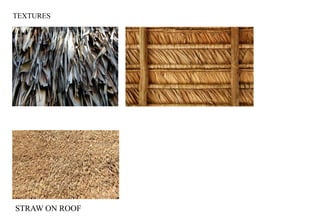Thatch Roof.pdf
- 1. Thatch Roof
- 2. Thatched roof - a house roof made with a plant material (as straw) Thatching is the craft of building a roof with dry vegetation such as straw, water, reed, rushes, or heather, layering the vegetation so as to shed water away from the inner roof. Sedge, a grass-like plant which grows in wetland areas, is also used extensively in ridging It is a very old roofing method and has been used in both tropical and temperate climates. Thatch is still employed by builders in developing countries, usually with low-cost, local vegetation.
- 6. ADVANTAGES OF THATCHED ROOF •Ideal for places with hot climate because it acts like an insulator •Thicker the layers house becomes more cooler •Cost saving •In cooler days thatched roof keeps heat sealed in •Naturally waterproof- water reed is used as material in making of the roof •Reeds are hollow and does not absorb water. Reeds placed a foot high will ensure that no moister will penetrate through roofing •Lifespan of thatched roof is fairly long especially made of high grade. With proper care and maintenance the roof can last for altleast 50 years •Environment friendly material
- 7. DISADVANTAGES OF THATCHED ROOF •A thatch roof is very vulnerable to being damaged and stripped by birds •Thatch roofs can be protected from bird damage with the use of plastic or wire mesh. This prevents the birds from stripping the thatch, but does tend to take away from the attractiveness of the roof •It must be noted however that wire mesh has the additional disadvantage of also rusting. This means that it has to be replaced from time to time. •Thatch roofs also tend to have a weak point at the ridge of the roof. •Needs lot of maintenance
- 8. MATERIALS WATER REED •All the new constructed properties are thatched in water reed since it is the most durable of the thatching materials, and tends to give the longest life. •Life Span: average of 50-60 years although there are instances of roofs lasting much longer than this. LONGSTRAW •long-stemmed varieties of wheat are grown and cut whilst still slightly green. After being allowed to dry, the wheat is threshed in a threshing drain and the resultant straw leaves the drum in a fairly mixed state. •As it is more easily attacked by birds, netting is usually fitted to the whole of the roof. WATER REED LONGSTRAW







